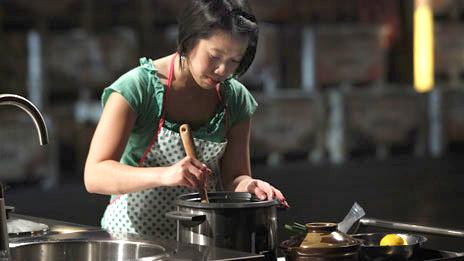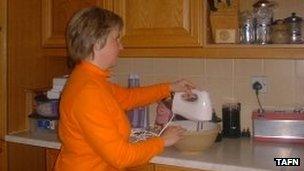Blind cooking: 10 tips from chefs
- Published
- comments

A blind contestant has reached the final stages of a US version of the television cooking competition, MasterChef, highlighting the difficulties faced by blind chefs. Emma Tracey, a producer on the BBC Ouch! disability blog and talk show, who has been blind since birth, says cooking provides many challenges.
Christine Ha, who is 33 and gradually lost her vision over a decade, made it to the final 18 of the MasterChef competition after impressing the judges, who include Gordon Ramsay.
Ha says she has to depend a lot more on the other senses to cook - taste, smell and how ingredients feel at different stages of cooking.
To taste everything - and to know how a perfectly cooked steak or fish fillet feels - is useful advice for any cook. So in what other ways do blind chefs manage?
1. Hazelnuts top left
On MasterChef, Ha is allowed an assistant to guide her around the unfamiliar kitchen and collect ingredients. Other than that, she is expected to follow the same rules as her sighted rivals.
But when cooking at home, she has no need for such assistance. Like many blind cooks, she knows her own kitchen inside out - and everything is always put back in its place.
Tom Lewis, head chef at Monachyle Mhor in Perthshire, remembers the need for strict organisation from when his mother Jean ran the restaurant's kitchen. She started it after losing her vision, and it was a smoothly run operation.
"You have to put ingredients back in the same place each time," he says. "In mum's kitchen, everything was as it should be - hazelnuts in the top left of the pantry, sugar bottom right."
2. Audio labelling
Many of the men and women that cookery expert Sue Pallett advises at online blindness community <link> <caption>The Accessible Friends Network</caption> <url href="http://www.tafn.org.uk/" platform="highweb"/> </link> , are not able to memorise the entire contents of their pantry and so must find a non-visual way to label items.
Blind from birth, Pallett uses Braille labels, but over the years she has developed a number of strategies to help others to identify their ingredients.
"If there are two containers which feel exactly the same, some people will put an elastic band on one and a piece of sticky tape on the other. Or tactile magnetic letters can be useful, particularly when labelling tins."
More hi-tech options are available, allowing the blind cook to record an audio message on a special label, which is then attached to the container.
As well as identifying the contents, this message can also include additional information, such as use-by dates and cooking instructions.
3. Listen to the sponge cake
Smell, taste, touch and even hearing are used by blind cooks to identify similar ingredients - using icing sugar instead of cornflour, for instance, would have disastrous consequences for a dish.

In China, a contest was held involving blind chefs
Pallett, who teaches blind people how to cook, says that if you have a refined sense of hearing, it is sometimes possible to tell that a sponge cake is done "when it stops ticking", or sizzling.
She is keen to point out, however, that this is not by any means a foolproof method and that timing is more reliable.
"As blind cooks, we are not able to continually open the oven door and check whether a cake is done, so I use a timer.
"When time is up, I press my fingers down lightly on the top of the cake and if it springs back easily, then it is done." Baking guru <link> <caption>Mary Berry also recommends this method</caption> <altText>BBC Food</altText> <url href="http://www.bbc.co.uk/food/techniques/testing_to_see_if_a_cake_is_cooked" platform="highweb"/> </link> .
4. Smell the garlic
"My sense of smell has really come into play since I lost my sight," says Ha, who <link> <caption>writes the food blog Blind Cook</caption> <url href="http://www.theblindcook.com/" platform="highweb"/> </link> .
"I know when garlic is just fragrant enough and when it is going to tip over to being too burnt or bitter.
"With a pan on the stove, I add some water and if it splashes in a certain way I know that it is hot enough for whatever I'm cooking."
5. Mark the temperature dials
Pallett uses small, brightly coloured pieces of sticky-backed rubber called bump-ons.
They come in many shapes and sizes and can be stuck on to anything, including the temperature dials of cookers and kitchen timers.
Then all the blind cook must do is line the cooker knob's edge up with them.
6. Have a chopping system

The sharper the better
Preparing vegetables requires the right tools and a good technique, says Pallett.
"Choose a short-bladed, unserrated kitchen knife with an ergonomic handle, and a good chopping board."
Blind foodie Neil Barnfather adheres to a strict system for preparing vegetables, especially while hosting dinner parties. And his favourite kitchen utensil is his knife sharpener - a <link> <caption>sharp blade is essential for chopping accurately</caption> <altText>BBC Food</altText> <url href="http://www.bbc.co.uk/food/techniques/dicing_onions" platform="highweb"/> </link> .
"When chopping, I tend to put the unchopped on the left, work in progress in the middle and finished on the right. This saves time and avoids confusion."
7. Saucepan, not frying pan

Sue Pallett doesn't use a frying pan
Another aspect of cooking which could be considered risky if you can't see, is working with hot oil. Pallett has found a way around this problem - instead of a frying pan, she uses deep-sided saucepans.
"If you fry in a saucepan, everything is contained really well and nothing is going to fly out over the top and cause a mess.
"I use a long-handled, heat-resistant, slotted spoon to slide underneath the ingredients, gently turn them over and spread them out again. I always face my saucepan handles to the same side.
"That way, I know where they are, and there's no chance of me knocking a hot pot off the hob."
8. Carry as little as possible
When serving a meal to guests, Neil Barnfather's secret weapon is a hostess trolley.
"It keeps food warm, so that I can cook one thing at a time. It also saves me having to carry a loaded tray through to the dining room, which, with a young family, or guests moving around, might not be a safe thing to do."
He also draws the line at serving gravy to guests at the table, opting instead to leave it on a heated serving plate in the centre so that they can do it themselves.
9. Use talking gadgets
All three cooks use various gadgets to get the job done. Many of these are regular pieces of equipment which have been repurposed.
For example, unable to go down the usual road of checking his meat by seeing if the juices run clear, Barnfather uses a <bold>meat tenderiser</bold>, which looks like a mini cheese-grater with a hammer-like handle. If, when pushed into the meat, it springs back easily, then the meat is cooked.
"I use <bold>oven mits which go much higher up my arm</bold> than regular mits, so that I don't burn the inside of my wrist when taking things in and out of the oven," says Ha.
She also has a <bold>talking meat thermometer</bold> with her in the MasterChef kitchen to ensure that her food is fully heated through. This is just one type of specialist equipment for the visually impaired, sold by blind charities such as RNIB.
When measuring ingredients for cakes and pastries, all three cooks rely on hearing to use their <bold>talking weighing scales</bold>. These devices speak measurements in a slow, clear voice, as ingredients are added to the bowl attached.
For liquids, Neil Barnfather says that the <bold>talking measuring jugs</bold> available are not nearly accurate enough to use. Instead, he remembers how much each of his jugs contains and places a clean finger on the inside of the container as he pours.
10. Serve up using a clock face
Like many blind people, Barnfather thinks of the plate as a clockface and divides it into quadrants.
"I like to know that my meat is at 12 O'clock, vegetables at three and potatoes at maybe six o'clock."
He takes mental notes on presentation and plate layout when eating in restaurants, so that he can tap into current trends when cooking for guests at home.
To serve, he plates up the meat or fish first and then arranges side dishes around it. An ice cream scoop proves invaluable for neatly serving mashed potato.
<italic>Read more from Emma Tracey on</italic> <link> <caption>the BBC Ouch! blog</caption> <altText>Ouch!</altText> <url href="http://www.bbc.co.uk/blogs/ouch/emma/" platform="highweb"/> </link>